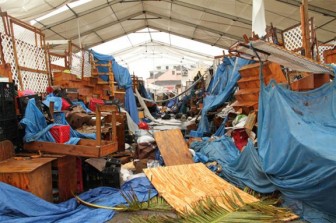WILMINGTON, N.C., (Reuters) – Hurricane Irene closed in on the U.S. Atlantic coast yesterday, triggering emergency preparations that included unprecedented evacuations and mass transit shutdowns in New York City as the menacing storm approached.

As Irene careened north, rain and tropical storm force winds and ferocious surf began pummeling the North Carolina coast. “The core of the hurricane will approach the coast of North Carolina tonight and pass near or over the North Carolina coast today,” the U.S. National Hurricane Center said in an advisory last evening.

Washington and states from the Carolinas through Maine declared emergencies due to Irene, a nearly 600 mile (960 km)-wide hurricane that put 55 million Americans on the eastern seaboard on alert and that experts say could cause billions of dollars in damages.
President Barack Obama said the impact of the storm, an unusually large storm, could be “extremely dangerous and costly” for a nation that still remembers destructive Hurricane Katrina in 2005. “All indications point to this being a historic hurricane,” Obama said.
Hundreds of thousands of residents and vacationers were evacuating from Irene’s path.A quarter of a million New Yorkers were ordered to leave homes in low-lying areas, including the financial district surrounding Wall Street in Manhattan, as authorities prepared for dangerous storm surge and flooding tomorrow in the city and farther east on Long Island.
Some New York hospitals in flood-prone areas were already evacuating patients, and New York’s mass transit system, which carries 8.5 million people on weekdays, was due to start shutting down around noon (1600 GMT) today.
“We’ve never done a mandatory evacuation before and we wouldn’t be doing it now if we didn’t think this storm had the potential to be very serious,” Mayor Michael Bloomberg told a news conference.
MEMORIES OF KATRINA
As U.S. authorities ramped up preparations to cope with a potential major natural disaster on the densely populated East Coast, U.S. airlines canceled more nearly 7,000 flights and moved airplanes out of Irene’s path.Officials were taking every precaution with Irene because they remember all too well how Katrina swamped New Orleans, killing up to 1,800 people and causing $80 billion in damages.
Defense Secretary Leon Panetta said the military stood ready to aid in the response to Irene, with more than 100,000 National Guard forces available if needed in eastern states. Coastal communities stocked up on food and water and tried to secure homes, vehicles and boats. Cities, ports, hospitals, oil refineries and nuclear plants activated emergency plans.
The earliest edges of Irene began to knock down trees, caused localized flooding and had knocked out power to 7,600 residents of Wilmington, North Carolina by last night.
People huddling in a shelter at a local school said they feared the storm’s potential impact but were reluctant to evacuate entirely.
“We were going to go to Charlotte, but we were told we might not be able to get back if there was a lot of damage,” said Chastity May, 34, as she watched over her 4-year-old son.
Some were looking to capitalize on the approaching storm.
Greg Bayly, 52, and Scott Olden, 24, were selling generators out of a rented cargo truck along a busy Wilmington street that leads out to nearby beaches. Bayly said the pair could process credit cards to complete purchases, despite the rapidly deteriorating weather conditions.









